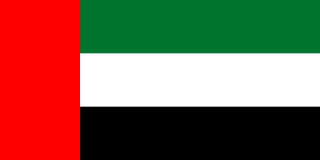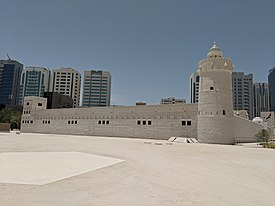Sheikh Shakhbut bin Dhiyab Al Nahyan was the Ruler of the Emirate of Abu Dhabi from 1793 to 1816, now part of the United Arab Emirates (UAE).
Sheikh Dhiyab ibn Isa Al Nahyan was the Sheikh of the Bani Yas of the Liwa Oasis from 1761 to 1793 and the founder of the Al Bu Falah dynasty, which still rules Abu Dhabi, the capital of the United Arab Emirates (UAE), today.

Sheikh Khalifa bin Zayed bin Sultan Al Nahyan was the second president of the United Arab Emirates and the ruler of Abu Dhabi, serving from November 2004 until his death in May 2022.

Sheikh Zayed bin Khalifa Al Nahyan, also known as Zayed the Great or Zayed the First was the Sheikh of Abu Dhabi from 1855 to his death in 1909. He was the grandfather and namesake of Sheikh Zayed bin Sultan, founder of the United Arab Emirates.

Jabal Hafeet is a mountain in the region of Tawam, on the border of the United Arab Emirates and Oman, which may be considered an outlier of the Hajar Mountains in Eastern Arabia. Due to its proximity to the main Hajar range, the mountain may be considered as being part of the Hajar range. To the north is the UAE city of Al Ain, in the Eastern Region of the Emirate of Abu Dhabi, and the adjacent Omani town of Al-Buraimi.

The Emirate of Abu Dhabi is one of seven emirates that constitute the United Arab Emirates. It is the largest emirate, accounting for 87% of the nation's total land area or 67,340 km2 (26,000 sq mi).

The House of Nahyan is the ruling royal family of the Emirate of Abu Dhabi, and one of the six ruling families of the United Arab Emirates. The family is a branch of the House of Al Falahi, a branch of the Bani Yas tribe, and are related to the House of Al Falasi from which the ruling family of Dubai, the Al Maktoum, descends.

The Emiratis are the citizen population of the United Arab Emirates. Within the UAE itself, their number is approximately 1.15 million.
The Abu Dhabi Cultural Foundation was founded in 1981 as a center of art and learning. It is located in the middle of downtown Abu Dhabi, UAE, off Khalifa Street and next to the White Fort, also known as Qasr al-Hosn Palace. The center hosts a variety of events, including art exhibits, lectures, concerts and movies, and arts workshop classes. The foundation is operated under the Abu Dhabi Authority for Culture and Heritage.
Mass media in the United Arab Emirates is subject to government control and censorship. Media freedom is severely curtailed in the UAE. Most UAE media is owned by the government or by groups that have ties to the government. UAE law permits the government to censor content critical of the government. Journalists and writers who criticize the government are subject to repression.

Abu Dhabi is the capital city of the United Arab Emirates. The city is the seat of the Abu Dhabi Central Capital District, the capital city of the Emirate of Abu Dhabi, and the UAE's second-most populous city, after Dubai. The city is situated on a T-shaped island, extending into the Gulf from the central-western coast of the UAE.
ALHOSN University was an educational institution founded in 2005 and located in Abu Dhabi, the capital city of the United Arab Emirates. It is a segregated University with separate campuses for Male and Female Students. The Abu Dhabi–based university was accredited by the UAE Ministry of Higher Education and Scientific Research.

Sheikh Zayed Palace Museum, also known as "Al Ain Palace Museum", is a museum in the city of Al Ain, within the Emirate of Abu Dhabi, United Arab Emirates.
The Abu Dhabi Authority for Culture and Heritage was a statutory body in the United Arab Emirates that administered cultural heritage in the Emirate of Abu Dhabi. In 2012, it merged into the Abu Dhabi Tourism and Culture Authority.

The United Arab Emirates has an embassy in London while the United Kingdom of Great Britain and Northern Ireland maintains an embassy in Abu Dhabi and is unique in having another embassy in Dubai, albeit with His Majesty's Consul-General to Dubai and the Northern Emirates, as opposed to a separate British Ambassador. The UAE-UK relations have been described as a "special relationship".

Qasr Al Muwaiji, or "Muwaiji Fort", is a fort in the central part of Al Ain in the Eastern Region of the Emirate of Abu Dhabi, the United Arab Emirates. It is noted as the birthplace of Sheikh Khalifa bin Zayed Al Nahyan, the former Ruler of Abu Dhabi and President of the U.A.E. (2004–2022), and where his father and predecessor, Zayed bin Sultan Al Nahyan, was based during his tenure as the Ruler's Representative of the Eastern Region of the Emirate.

Qaṣr Al-Waṭan is the presidential palace of the United Arab Emirates, located in Abu Dhabi.
Sharjah Book Authority (SBA) is a governmental entity, established in 2014 in Sharjah, United Arab Emirates. It operates in several sectors, under the literary umbrella; including publishing, printing, book translation, book festivals, and children's literature.

Timothy Power is an archaeologist who specializes in Arabia and the Islamic World. He completed his doctorate in Islamic Art and Archaeology at the University of Oxford in 2003. His doctorate focused on the Red Sea basin from Byzantium to the Caliphate, which was later published as a book by the American University of Cairo (AUC) Press.















